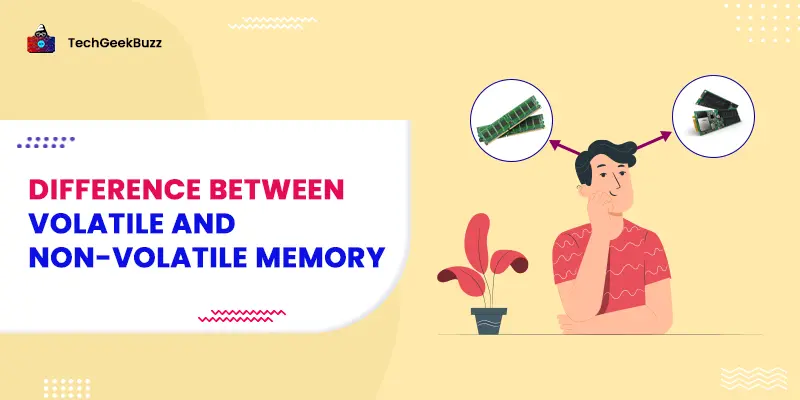Memory plays a crucial role in holding data that a computer’s CPU needs to process. It also serves as a storage medium for storing the results of processing. It is one of the basic functions of a computer . Without memory, it is impossible to store data. Hence, a computer cannot perform its tasks.
Computer memory is broadly categorized into two types based on the nature of holding data and functionality. These categories are volatile and non-volatile memory, which are hardware-based memories.
The primary difference between volatile and non-volatile memory is that volatile memory stores data temporarily, while non-volatile memory stores it permanently. Both are necessary for the proper functioning of a computer.
Besides the basic difference, there are many other differences between these two memory types. This blog post will walk you through those differences and enlightens you on the importance of volatile and non-volatile memory.

What is Volatile Memory?
Volatile memory is a type of computer memory that requires a continuous power supply to retain data. Once a computer is disconnected from the power supply or when it becomes inoperative, it loses or erases all the data it holds. This means it retains data temporarily, hence the name temporary memory.
A computer’s processor can easily access the data stored in volatile memory. Hence, it offers faster and more cost-effective storage and retrieval.
This memory stores only the data a computer processor requires to execute a certain process or task currently. After the processor executes the task, the immediate result is again stored in volatile memory for faster access for the subsequent operation.
To store the result permanently, it must be backed up in a permanent or secondary storage medium.
Read in detail: Volatile Memory
Examples
- Random Access Memory (RAM): It is the primary memory or main memory that stores data a CPU currently needs to perform a task or execute a program.
- Cache Memory: It stores data that a CPU needs to access frequently for faster retrieval.
Advantages and Disadvantages

Advantages
- Volatile memory consumes less power than a hard disk, a non-volatile memory when connected to the power supply.
- It performs faster read and write operations.
- A computer’s CPU can directly access volatile memory.
- It offers high speed.
- This high speed results in better system performance.
Disdvantages
- Volatile memory stores data temporarily. It erases all data automatically once a computer system shuts down or disconnects from the power supply.
- It has a limited storage capacity.
- It is very expensive.
What is Non-Volatile Memory?
Non-volatile memory does not require a consistent power supply to retain its data. It does so even if a computer enters an inoperative state or disconnects from the power supply. Hence, it is referred to as permanent memory.
Compared to volatile memory, non-volatile memory's read and write speed is comparatively slower. The reason is that a CPU cannot directly access non-volatile memory. The data must first be loaded into volatile memory to make it accessible for the CPU. As a result of this process, non-volatile memory is slower in terms of speed.
This memory provides large storage capacities at affordable prices and is available in different forms. As a result, it is ideal for storing large amounts of data for an extended time period.
Read in detail: Non-Volatile Memory
Examples
- ROM: Read-Only Memory is not electronically modified after its manufacturing. Hence, it stores data or instructions that do not need modifications.
- Flash Memory: This memory can be electrically erased and reprogrammed. Consumer devices, enterprise systems, and industrial applications commonly leverage flash memory.
- Hard Disk Drives: Usually found in computers and laptops, a hard disk drive is an electromagnetic storage medium that leverages mechanical components, such as spinning disks and read/write heads, to read and write data.
- Solid-State Drives: Modern computers and laptops feature solid-state drives, semiconductor memory chips with no moving parts. It leverages flash memory.
- Optical Disk: It is a flat, round disk that leverages laser beams to read and write data. CDs, DVDs, and Blu-Ray disks are the three major types of optical disks available today.
Advantages and Disadvantages

Advantages
- Non-volatile memory retains data permanently until a user erases or deletes it.
- It is ideal for persistent data storage.
- It does not require a constant power supply to retain data.
- You can find non-volatile memory in different forms.
- It is available in large storage capacities.
- It is less expensive compared to a temporary storage medium.
Disadvantages
- A CPU cannot access non-volatile memory directly. This results in slower read and write operations.
- ROM, a non-volatile memory, supports only the read operation. However, its variations, like EPROM and EEPROM, support read and write operations.
Difference Between Volatile and Non-Volatile Memory
The following table highlights the difference between volatile and non-volatile memory:
|
Parameters |
Volatile Memory |
Non-Volatile Memory |
|
Definition |
It is a type of computer memory that stores data temporarily. |
It is a type of computer memory that stores data permanently. |
|
Power Supply Requirement |
Volatile memory requires a consistent power supply to retain data. Otherwise, data would get lost. |
Non-volatile memory does not require the power supply to retain data. |
|
Read/Write Speed |
Its read/write speed is much faster than non-volatile memory. |
The read/write speed is relatively slower. |
|
Type of Data Stored |
This memory stores data a computer’s CPU requires to process a specific task or program . |
Generally, non-volatile memory stores data that needs no changes. For instance, it holds data and instructions essential for the booting process. |
|
Data Transfer |
Data transfer is an easy task. |
The data transfer takes time compared to volatile memory. |
|
Process Read/Write |
A process can read and write data and write data in volatile memory. |
A process cannot read and write data in non-volatile memory. |
|
Storage Capacity |
Volatile memory has a limited storage capacity. |
Non-volatile memory has high storage densities. |
|
Permanency |
The data in this memory is temporary. Hence, it is referred to as temporary memory. |
The data in this memory is permanent. Hence, it is referred to as permanent memory. |
|
CPU Access |
A computer’s CPU can easily access data stored on volatile memory. |
The CPU cannot directly access non-volatile memory. Hence, the data from non-volatile memory is first loaded into volatile memory to make it accessible for the CPU. |
|
Cost |
This memory is expensive and offers less storage. |
It is cost-effective memory, offering a large amount of storage. |
|
Position |
Volatile memory chips are found on memory slots. |
Non-Volatile memory chips are embedded in the motherboard. |
|
Example |
Examples are Random Access Memory (RAM) and cache memory. |
Examples are Read-Only Memory (ROM), flash memory, hard disk drives, solid-state drives, and optical disks. |
Conclusion
Here ends our discussion on the difference between volatile and non-volatile memory. Both memory types play a crucial role in improving a computer’s overall performance. While volatile memory improves the efficiency of task execution by offering quick access to data, non-volatile memory provides persistent data storage.
Together these memory types ensure smooth operations and persistent data retention in modern computer systems.
We tried to cover all significant differences. If you know any other apart from the ones mentioned above, let us know in the comments.
People are also reading:


![What is an Assembler? [Definition, Working, & Types]](/media/new_post_images/What_is_Assembler.jpg)
![What is I/O? [Types, Examples, & Methods]](/media/new_post_images/What_is_I_O.webp)
